Economics in Three Dimensions
The modern left-right political spectrum is loosely defined and of questionable usefulness. Here, I will define the spectrum in a very precise way and then extend it into a three-dimensional model. But this will no longer be a political model. Instead, all three of the dimensions will reflect economic factors. Two of them are continuous spectra: the left-right axis is about “concentrated”/“communitarian” versus “distributed”/“individualist”/“syndicalised” economic institutions; the up-down axis is about whether these institutions are hierarchically organised or not. The third dimension is a binary distinction between the market economy and the natural economy, or (near-equivalently) between capitalism and communism.
This defines a cube, with eight key economic systems corresponding to the eight vertices of the cube, as shown:
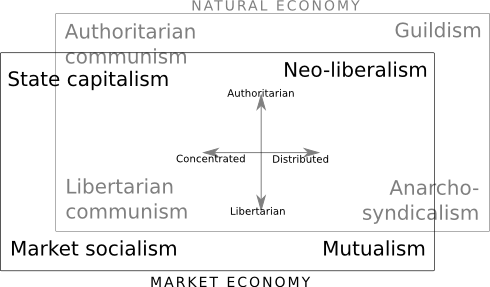
Now I have to clear up all the terminological mud.
The system is based on my understanding of what property is. In particular, I believe property has a bilateral definition: property is (1) that which you control without using it or without being the one who exclusively needs it, (2) that which you can sell or exchange. These two factors distinguish property from possession. A possession is something which you control because you are using it and because you need it. Property is therefore inherently exploitative, but it is a bilateral exploitation. For example, suppose that a person A is starving and has need of a loaf of bread. Suppose that the loaf of bread is the property of another person B. By definition, B does not need and is not using the loaf of bread, but there are two ways that B can control it, or two ways of exploiting A. They can exploit by authority: for example, they can force A to do something for them, which could be quite arbitrarily defined, in return for the bread. Or they can exploit them economically by forcing them to pay them for the bread. An economic system that is based on exchange is one that is based on private property and is therefore inherently exploitative. A market economy is nothing more than an economic system based on exchange where the exchange is denominated in money.
These two kinds of exploitation don’t necessarily go together, so we can be more precise by defining two kinds of property from them. There’s property that is used to exploit people authoritatively and arbitrarily, which I’ll call Property(A), and there’s property that’s used to exploit people economically via exchange or debt, which I’ll call Property(E). In capitalism, the two kinds of property go hand in hand and many people will barely be able to separate them. Wage labour is both authoritarian and economic exploitation at the same time. I’ll call this Property(AE). It’s worth pointing out, however, that Property(E) still meets both criteria in the definition of property, given that when you sell something, the person who needs it is not you (almost by definition) - it’s the buyer who needs it. So Property(E) is similar to Property(AE), but the exploitation arises solely through the act of exchange, and there are no arbitrary conditions or prejudices attached to the act of exchange - in other words, a pure free market transaction.
Property(A) and Property(E) are ways of being exploited and also ways of being alienated from your labour. Somebody who owns Property(E) is called a capitalist. Somebody who owns Property(A) is called an autocrat. In a hierarchical capitalist enterprise, Property(E), or the spectre of capital, alienates and exploits the capitalists, who in turn alienate and exploit the workers as autocrats. In a workers’ co-op, capital alienates the worker-capitalists directly.
The four types of property are illustrated in the diagram below, which is based on the same cube but with the x-axis collapsed. (The “left” is now in the centre, and the “right” is at the edges.)
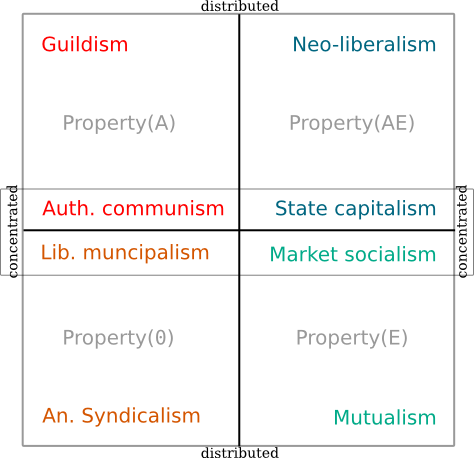
The absence of Property(E) is how I define communism (for the purposes of this model). It’s the discontinuity between the market/capitalist and non-market/communist planes. This is indicated on the z-axis (the depth). But I don’t think there is any “spectrum” or “continuum” on this axis, i.e. between “less market-oriented” and “more market-oriented” systems. For me, the distinction between market and non-market economy is binary. Either money exists and is used systemically to organise the economy, or it isn’t. The dichotomy between the “natural” and “market” economies is practically equivalent to the dichotomy between communism and capitalism respectively.
The y-axis in the model plots the degree of authoritarian control over products and means of production. So systems at the bottom in the market plane are based primarily on Property(E), while systems at the top in the market plane are based on Property(AE). Systems at the top in the natural plane are based on Property(A), while systems at the bottom in the natural plane have no property at all, and are based solely on possession/usufruct. (This could alternatively be called Property(0), or null property, to reflect the absence of exploitative/alienating relations.)
It’s important to note that this means the precise character of the y-axis differs depending on whether you’re on the left or the right. On the left, the state or the community federation are the only economic institutions that exist, so the vertical axis is about whether this single institution is authoritarian or not. On the right, however, the economy is more distributed, so there are lots of economic institutions, whether you want to call them businesses, enterprises, guilds or workplaces. So the vertical axis at this end of the scale is about whether the workplaces are authoritarian, with bosses and managers and so on, or libertarian, with a co-operative structure.
As for the x-axis, it relates to whether the control is concentrated or distributed - or, perhaps more precisely, whether economic control is primarily vested in a centralised communitarian institution, or in decentralised workplace institutions. The left puts emphasis on the collective - the state, the nation, the community or the polis; the right puts emphasis on the agents of production - capitalists, workers, consumers and individuals.
Now let’s go through each of the eight vertices of the cube, starting with the front face:
If Property(AE) is under concentrated control, that means most or all of the property is in the hands of a single organisation, which we call the state. So I’m calling that system state capitalism. Stalinism and the USSR are examples. The reason that they were not communist is because they failed to abolish Property(E).
If control over Property(AE) is more distributed, i.e. owned by lots of different economic units, then that’s neo-liberalism, where the economic units are generally organised hierarchically with managers and owners. That’s the world most of us live in today. So we have a spectrum from Stalinism to Neo-liberalism. Fascism is usually positioned halfway between these systems on the x-axis. Conservatism, neo-conservatism and (American) libertarianism are all conflated into the same category at this position; this is because they mainly differ in social or political issues, not in economic issues.
If Property(E) is under concentrated control, then the economic institutions are democratically organised and the state is able to intervene in the economy, invest in it and participate in it again under quite democratic principles. This could be called market socialism, a term often associated with the former Yugoslavia. But the most left-wing version of this system would be one where the state is the “true” owner of all the means of production, with democratic control being exercised via participatory budgeting, votes on economic plans and workplace democracy. I will call this democratic socialism.
If Property(E) is under distributed control, then there is only a minimal state and all economic institutions are controlled by their members - that is, as co-operatives or mutuals. This is mutualism. Unlike in market socialism, there is no welfare state in this system and no social security. People have to rely on mutual banks and co-operative healthcare.
Those four systems are the “capitalist” systems, defined by their use of Property(E). All of them feature private property and economic exploitation via an exchange system. Social democracy, or Keynesianism, is somewhere in the middle of the plane: it’s more authoritarian than market socialism or mutualism because businesses are usually hierarchical, but it’s also more democratic than fascism, and more left-wing than neo-liberalism because some forms of property (namely, public services) are concentrated in the hands of the state. Here’s a slightly more in-depth view of the market plane:
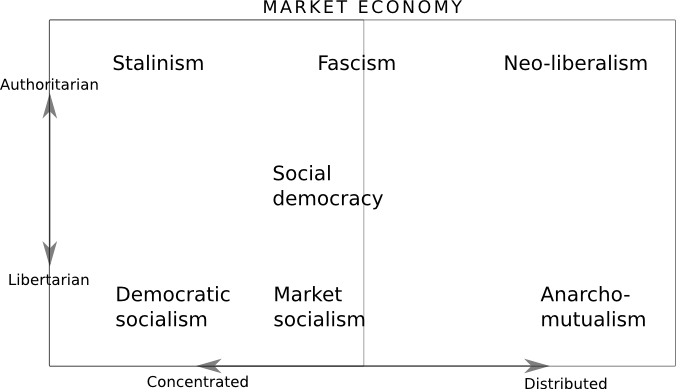
Now let’s look at the communist plane.
If Property(A) is under concentrated control, and exchange has been abolished in favour of a natural economy, then we end up with what I call authoritarian communism. In the extreme version of this system, a state bureaucracy decides on what to produce and how to produce it as well as dictating who will do what in terms of labour. This is the economic plan. Economic output is determined - perhaps arbitrarily - by the planning committee. As such, the economy can grow or contract according to the whim of the bureaucrats. Money is not needed, but people would probably be forced to accept a role in the plan. This is not how the Soviet Union worked: as I said, it was actually a state capitalist system. But if the exchange system had been abolished, this is roughly what you’d get.
If Property(A) is under distributed control, then there is no central planning and the means of production are in the hands of numerous producing units, which I call guilds. Each guild is run in an authoritarian manner, perhaps with a leader or an aristocrat, or just someone who is very skilled technically with many apprentices under them, or in other ways. But money is not used - otherwise we’d be in anarcho-mutualist territory. Instead, the guilds have agreements with each other about where to send their goods. Labour contributions would probably be required, but there could also be all kinds of other power games between the guilds. The important point is that the economy is “emergent” rather than planned. For want of a better word, I call this guildism. Somewhere between guildism and authoritarian communism are the medieval free states, which had lots of independent artisans as well as municipal authorities.
If property is completely abolished and the means of production are under concentrated control, we have libertarian communism. Democratic assemblies decide what needs to be produced and how, as well as how to divide up the labour. Delegates are sent to regional councils to decide how to use regional and supra-regional resources. Bookchin’s libertarian municipalism is the extreme example, where all separate workplaces (all the guilds) have been extinguished, and the economy is completely absorbed into public policy as decided by the municipal assemblies and their confederal councils. Somewhere between this system and authoritarian communism is the system called participatory economics or parecon.
If possession is under distributed control, then the community federation and the municipal councils and any last vestiges of anything state-like have all been abolished, and the economy is run entirely by autonomous guilds and by the free agreements and associations between them. They might decide to form a federation, where delegates from every guild in the region are sent to a regional council, and delegates from every guild in a particular industry are sent to a branch council, where they can decide on how to divide up the work between them, how to match supply to demand and also share knowledge and expertise. Since all forms of authority and coercion have been abolished, all the guilds must be worker-controlled with horizontal decision-making; any delegates must be strictly mandated and recallable by the assembly that sends them. I will call this system anarcho-syndicalism (but see the addendum for a note on terminology).
A summary of the natural economic plane:
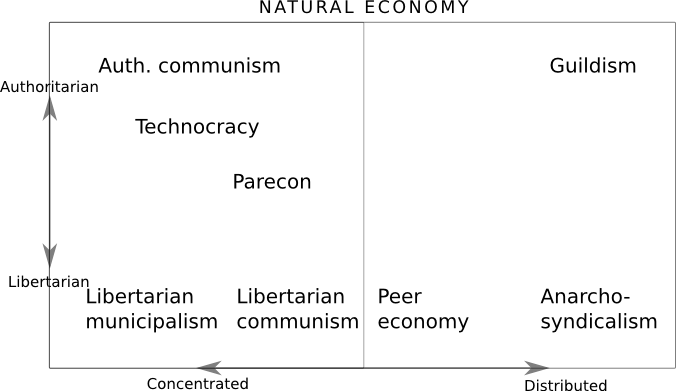
Changing the Property Relations
We can also now distinguish the four ways of changing the property status of some product or resource: nationalising it, privatising it, mutualising it or collectivising it. Nationalisation and collectivisation concentrate resources, while the other two distribute them. Privatisation and nationalisation make something into Property(A) and the other two reverse this. Nationalisation puts something into the hands of a state bureaucracy; collectivisation requires democratic control, so that it is de facto owned by citizens. Privatisation puts something in the hands of capitalists or autocrats; mutualisation puts it in the hands of workers or consumers.
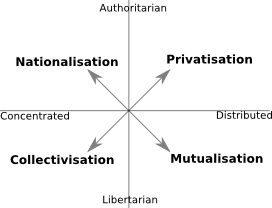
We’ve lost some resolution here by collapsing the z-axis of the cube. Hence there are two subtypes of each process, marketised and non-marketised, depending on whether Property(E) exists or not.
These four terms are usually used to refer to individual industries or institutions. This suggests that we could make the model more applicable to the real world by switching our focus away from economic systems and instead looking at institutions and productive elements in society. Capitalism today is not a “pure” or “ideal” version of neo-liberalism, and probably never will be. Society is not a single system that is positioned somewhere in the 3-dimensional spectrum, but rather an aggregate of different institutions, each of which has its own position on the spectrum depending on its property relations.
In our world as of 2014, there are, of course, enterprises - businesses that are hierarchically controlled and profit-motivated. Where the enterprises dominate, we can justifiably speak of neo-liberalism. Nevertheless, every type of property already exists in our society. There are workers’ co-ops. There are states, providing some public services, like the health service in Spain or the railways in Norway. Of course, some states are more authoritarian than others. Some open source projects are neither marketised nor authoritarian, so they arguably fall in the “anarcho-syndicalist” region. Most households are also economic institutions - places where productive activity such as cooking and child-rearing take place. The vast majority of these are non-marketised. Some of them regrettably are structured as authoritarian communes, while others are “true communes”, neither marketised nor authoritarian.
In general, the economic side of society is made up of communes and syndicates, guilds and states, some of them marketised, some of them not marketised, and authoritarian or libertarian to different degrees.
How Useful is this Model?
This 3D model allows us to talk about whole economic systems as well as to characterise different economic relations that co-exist within society. It also gives an appropriate amount of terminological precision, so that we can talk about economic reforms and systems with a certain amount of clarity.
In other models of this kind, money is assumed to play a role in any kind of society, and especially in the right wing. This model considers the use of money to be an independent variable, which allows us to see that right-wing values of autonomy and self-regulation transcend the exchange system. Other models also focus on the role of the state, ignoring the authoritarian nature of workplaces. This results in the exclusion of mutualism. Finally, libertarian communist systems are assumed to be left-wing, despite major differences between left-wing capitalist policies and left-wing communist policies. In the view presented here, moneyless societies occupy a separate plane, which allows us to explain the key economic differences arising from the absence of Property(E), without losing sight of the similarities.
Addenda
It should be noted that many actual anarcho-syndicalists aren’t as extremely “right” as claimed: usually, anarcho-syndicalism is considered to be a strategy rather than an economic system in itself, and the economic system that they espouse might involve a community federation as well. This would put them somewhere further left on the anarchist spectrum. But I needed a word to describe the system on the far right, and my thinking is that “anarcho” describes the libertarian (low y-value) position and “syndicalism” describes the distributed (high x-value) position. And, the syndicalist system in urban parts of the Spanish Revolution didn’t have a community or municipal federation. This is why Bookchin criticised syndicalism as “bourgeois co-operativism” (see below), implicitly identifying it with mutualism. The similarities and differences should be clear from the cube diagram.
“Libertarian communism” is terminologically ambiguous as well, since it could be used to cover both libertarian collectivist communism and libertarian distributed communism. The latter is what I called anarcho-syndicalism; the former is libertarian municipalism. The more specific terms can be used if necessary to avoid ambiguity. I have also put “libertarian communism” just to the right of libertarian municipalism, since I think this is usually what people are referring to when they use the term “libertarian communism” as a vision of a post-revolutionary society.
It’s important to realise that all three dimensions of the model are economic, not social. So the x-axis is about how concentrated or distributed the economic institutions are, not about whether people live in families or small communities or big cities or as lone rangers - this could vary independently. And the y-axis is about how authoritarian or libertarian the economic institutions are, not about whether the community has rules against incest or whether the state will put you to death if you murder someone. You could conceivably add these extra dimensions to the model, but then it would be difficult to draw a nice diagram of it, since humans cannot perceive more than three dimensions. It would allow us to split up neo-liberalism into libertarianism (socially liberal) and conservatism (not socially liberal) but other than that I don’t see many other useful distinctions you could make.
It might still be argued that a “market economy” can coexist in varying degrees with a natural economy, suggesting a continuous z-axis. Well, the key word is coexist. Historically the market economy existed in an incipient form alongside other, non-market kinds of economy. And in the present day, non-market economic systems also coexist with the more dominant market system. But these are examples of “dual power” in my view - two essentially different systems cohabiting in a society. One way to bring the natural economy to prominence, replacing the market economy, is via dual power. (My thanks to Andreas Exner for interesting discussion about this and other points.)
Arguably, my extremes at the right end of the spectrum aren’t extreme to the point of individualism, so we could add capitalist anarcho-individualism and communist anarcho-individualism on the far right, where every individual is a producer and there are no levels of co-operation. In these cases, the vertical dimension collapses, as the authoritarian-libertarian distinction makes no sense for an individual (i.e. we assume that an individual has authority over themself and thereby exercises their freedom). Extreme individualist communism would be a system where everyone is able to produce everything they need alone.
Note also that there are people who support a free market who nevertheless claim to be left-wing, such as mutualists and left libertarians. That’s fine: it should be clear why mutualism looks a bit left-wing, but my definitions of left and right are different and it just so happens that mutualism ends up on the right.
The Bookchin Problem
Bookchin criticised anarcho-syndicalism on three grounds:
Workplaces under workers’ self-management exclude the wider, non-working community from decision-making.
There is a danger that workers cannot separate their “vocational interests” from their interests as citizens when debating public policy.
The syndicalist federation is susceptible to bureaucratisation.
These problems might lead to self-managed workplaces abusing the means of production, polluting or exhausting natural resources or just ignoring what citizens, as consumers, actually want. This is a good argument for introducing a community federation that manages natural resources and intervenes if they are misused. On the other hand, if workplaces are organised as open source peer projects, it might be possible to avoid these problems without introducing a community institution. You have to rely on the idea that peer projects won’t get contributors if they do the “wrong” thing. Nobody is forced to work for anybody in this system, so contributors can always “exit”. Furthermore, projects can set up resource user groups to share possibly scarce resources between them in a sensible way, and the producers’ federation is very likely to set standards and sanction interventions to prevent ecological destruction. Peer projects also make it easy for consumers to have a voice too. A peer project is essentially a project where people with a common goal get together to provide something - for themselves as well as for others who have the same needs. By using open source methods, others can always check their work, contribute feature requests and report problems, and even “fork” the project by copying over all of the project’s plans and information resources to a new project.
The tendency for bureaucratisation is probably based on the idea that manual workers haven’t got time to participate in meetings and end up electing someone to do the job full-time. Parecon tries to solve this problem by enforcing a rotation of manual and administrative duties. Such a rotation could also be introduced voluntarily. Peer projects tend to use “rough consensus” as their decision-making model: they avoid having meetings, avoid voting; they give people a chance to object to something if they want, but if nobody objects they just do what they think is right. This might not always work, and some meetings will still be necessary, but cutting down on meetings is a good way to avoid bureaucratisation.
The extreme variety of anarcho-syndicalism where there is literally no community federation is probably unlikely to be desirable. Just like with so-called anarcho-capitalism, where a minimal state seems to be necessary, right-wing anarchists might support a minimal community federation. But this brief discussion should show that extreme anarcho-syndicalism is ideologically sound and isn’t necessarily going to collapse or descend into an authoritarian system.

